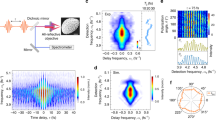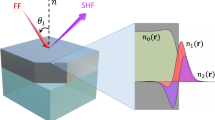Abstract
Light–matter interactions are inherently slow as the wavelengths of optical and electronic states differ greatly. Surface plasmon polaritons — electromagnetic excitations at metal–dielectric interfaces — have generated significant interest because their spatial scale is decoupled from the vacuum wavelength, promising accelerated light–matter interactions. Although recent reports suggest the possibility of accelerated dynamics in surface plasmon lasers, this remains to be verified. Here, we report the observation of pulses shorter than 800 fs from hybrid plasmonic zinc oxide (ZnO) nanowire lasers. Operating at room temperature, ZnO excitons lie near the surface plasmon frequency in such silver-based plasmonic lasers, leading to accelerated spontaneous recombination, gain switching and gain recovery compared with conventional ZnO nanowire lasers. Surprisingly, the laser dynamics can be as fast as gain thermalization in ZnO, which precludes lasing in the thinnest nanowires (diameter less than 120 nm). The capability to combine surface plasmon localization with ultrafast amplification provides the means for generating extremely intense optical fields, with applications in sensing, nonlinear optical switching, as well as in the physics of strong-field phenomena.
This is a preview of subscription content, access via your institution
Access options
Subscribe to this journal
Receive 12 print issues and online access
$209.00 per year
only $17.42 per issue
Buy this article
- Purchase on Springer Link
- Instant access to full article PDF
Prices may be subject to local taxes which are calculated during checkout






Similar content being viewed by others
References
Bergman, D. & Stockman, M. Surface plasmon amplification by stimulated emission of radiation: Quantum generation of coherent surface plasmons in nanosystems. Phys. Rev. Lett. 90, 1–4 (2003).
Ma, R., Oulton, R. F., Sorger, V. J. & Zhang, X. Plasmon lasers: Coherent light source at molecular scales. Laser Photon. Rev. 7, 1–21 (2012).
Lu, Y-J. et al. Plasmonic nanolaser using epitaxially grown silver film. Science 337, 450–453 (2012).
Oulton, R. F. Surface plasmon lasers: Sources of nanoscopic light. Mater. Today 15, 592–600 (2012).
Oulton, R. F. et al. Plasmon lasers at deep subwavelength scale. Nature 461, 629–632 (2009).
Noginov, M. A. et al. Demonstration of a spaser-based nanolaser. Nature 460, 1110–1112 (2009).
Ma, R., Oulton, R. F., Sorger, V. J., Bartal, G. & Zhang, X. Room-temperature sub-diffraction-limited plasmon laser by total internal reflection. Nature Mater. 10, 110–113 (2010).
Hill, M. T. et al. Lasing in metal–insulator–metal sub-wavelength plasmonic waveguides. Opt. Express 17, 11107–11112 (2009).
Stockman, M. I. The spaser as a nanoscale quantum generator and ultrafast amplifier. J. Opt. 12, 024004 (2010).
Kneipp, K. et al. Single molecule detection using surface-enhanced Raman scattering (SERS). Phys. Rev. Lett. 78, 1667–1670 (1997).
Nie, S. Probing single molecules and single nanoparticles by surface-enhanced Raman scattering. Science 275, 1102–1106 (1997).
Anker, J., Hall, W., Lyandres, O. & Shah, N. Biosensing with plasmonic nanosensors. Nature Mater. 7, 442–453 (2008).
Danckwerts, M. & Novotny, L. Optical frequency mixing at coupled gold nanoparticles. Phys. Rev. Lett. 98, 026104 (2007).
Aouani, H., Rahmani, M., Navarro-Cía, M. & Maier, S. A. Third-harmonic-upconversion enhancement from a single semiconductor nanoparticle coupled to a plasmonic antenna. Nature Nanotech. 9, 290–294 (2014).
Kim, S. et al. High-harmonic generation by resonant plasmon field enhancement. Nature 453, 757–760 (2008).
Yu, Z., Veronis, G., Fan, S. & Brongersma, M. L. Gain-induced switching in metal–dielectric–metal plasmonic waveguides. Appl. Phys. Lett. 92, 041117 (2008).
Khajavikhan, M. et al. Thresholdless nanoscale coaxial lasers. Nature 482, 204–207 (2012).
Ding, K. et al. Room-temperature continuous wave lasing in deep-subwavelength metallic cavities under electrical injection. Phys. Rev. B 85, 041301 (2012).
Khurgin, J. B. & Sun, G. Comparative analysis of spasers, vertical-cavity surface-emitting lasers and surface-plasmon-emitting diodes. Nature Photon. 8, 468–473 (2014).
Khurgin, J. B. & Sun, G. Scaling of losses with size and wavelength in nanoplasmonics and metamaterials. Appl. Phys. Lett. 99, 211106 (2011).
Khurgin, J. B. & Sun, G. Injection pumped single mode surface plasmon generators: Threshold, linewidth, and coherence. Opt. Express 20, 15309–15325 (2012).
Wuestner, S. et al. Control and dynamic competition of bright and dark lasing states in active nanoplasmonic metamaterials. Phys. Rev. B 85, 201406 (2012).
Kinkhabwala, A. et al. Large single-molecule fluorescence enhancements produced by a bowtie nanoantenna. Nature Photon. 3, 654–657 (2009).
Sorger, V. J. et al. Strong molecular fluorescence inside a nanoscale waveguide gap. Nano Lett. 11, 4907–4911 (2011).
Russell, K., Liu, T., Cui, S. & Hu, E. Large spontaneous emission enhancement in plasmonic nanocavities. Nature Photon. 6, 459–462 (2012).
Altug, H., Englund, D. & Vučković, J. Ultrafast photonic crystal nanocavity laser. Nature Phys. 2, 484–488 (2006).
Oulton, R. F., Sorger, V. J., Genov, D. A., Pile, D. F. P. & Zhang, X. A hybrid plasmonic waveguide for subwavelength confinement and long-range propagation. Nature Photon. 2, 496–500 (2008).
Trebino, R. Measuring the seemingly immeasurable. Nature Photon. 5, 189–192 (2011).
Zimmler, M. A., Capasso, F., Müller, S. & Ronning, C. Optically pumped nanowire lasers: Invited review. Semicond. Sci. Technol. 25, 024001 (2010).
Yoshikawa, H. & Adachi, S. Optical constants of ZnO. Jpn. J. Appl. Phys. 36, 6237–6243 (1997).
Shih, T., Mazur, E., Richters, J-P., Gutowski, J. & Voss, T. Ultrafast exciton dynamics in ZnO: Excitonic versus electron–hole plasma lasing. J. Appl. Phys. 109, 043504 (2011).
Klingshirn, C. ZnO: Material, physics and applications. ChemPhysChem 8, 782–803 (2007).
Röder, R. et al. Continuous wave nanowire lasing. Nano Lett. 13, 3602–3606 (2013).
Zimmler, M. A., Bao, J., Capasso, F., Müller, S. & Ronning, C. Laser action in nanowires: Observation of the transition from amplified spontaneous emission to laser oscillation. Appl. Phys. Lett. 93, 051101 (2008).
Versteegh, M. A. M., Vanmaekelbergh, D. & Dijkhuis, J. I. Room-temperature laser emission of ZnO nanowires explained by many-body theory. Phys. Rev. Lett. 108, 157402 (2012).
Rakic, A. D., Djurisic, A. B., Elazar, J. M. & Majewski, M. L. Optical properties of metallic films for vertical-cavity optoelectronic devices. Appl. Opt. 37, 5271–5283 (1998).
Palik, E. D. Handbook of Optical Constants of Solids, Author and Subject Indices for Volumes I, II, and III (Elsevier Science Technology, 1997).
Liu, X., Zhang, Q., Yip, J. N., Xiong, Q. & Sum, T. C. Wavelength tunable single nanowire lasers based on surface plasmon polariton enhanced Burstein–Moss effect. Nano Lett. 13, 5336–5343 (2013).
Klingshirn, C. F. Semiconductor Optics (Springer, 2007).
Lebedev, M. V. On the nature of ‘Coherent Artifact’. J. Exp. Theor. Phys. 100, 272–282 (2005).
Hendry, E., Koeberg, M. & Bonn, M. Exciton and electron–hole plasma formation dynamics in ZnO. Phys. Rev. B 76, 045214 (2007).
Casperson, L. W. Threshold characteristics of multimode laser oscillators. J. Appl. Phys. 46, 5194–5201 (1975).
Huang, M. H. et al. Room-temperature ultraviolet nanowire nanolasers. Science 292, 1897–1899 (2001).
Böhringer, K. & Hess, O. A full-time-domain approach to spatio-temporal dynamics of semiconductor lasers. I. Theoretical formulation. Prog. Quantum Electron. 32, 159–246 (2008).
Acknowledgements
This work was sponsored by the UK Engineering and Physical Sciences Research Council (EPSRC), The Leverhulme Trust as well as the Deutsche Forschungsgemeinschaft (FOR 1616). R.F.O. is supported by an EPSRC Fellowship (EP/I004343/1) and Marie Curie IRG (PIRG08-GA-2010-277080).
Author information
Authors and Affiliations
Contributions
The nanowires where grown by R.R. and S.G.; the simulations were performed by T.P.H.S. and R.F.O.; the experimental measurements were conducted by T.P.H.S.; results were discussed and interpreted by all authors; the manuscript was written by T.P.H.S. and R.F.O. with feedback from all co-authors.
Corresponding authors
Ethics declarations
Competing interests
The authors declare no competing financial interests.
Supplementary information
Supplementary Information
Supplementary Information (PDF 2175 kb)
Rights and permissions
About this article
Cite this article
Sidiropoulos, T., Röder, R., Geburt, S. et al. Ultrafast plasmonic nanowire lasers near the surface plasmon frequency. Nature Phys 10, 870–876 (2014). https://doi.org/10.1038/nphys3103
Received:
Accepted:
Published:
Issue Date:
DOI: https://doi.org/10.1038/nphys3103
This article is cited by
-
Ultra-small low-threshold mid-infrared plasmonic nanowire lasers based on n-doped GaN
Discover Nano (2023)
-
High-Q lasing via all-dielectric Bloch-surface-wave platform
Nature Communications (2023)
-
Plasmonic nano-laser at 675 nm for biomedical applications
Journal of Optics (2023)
-
Finite-element Analysis of Low-threshold Perovskite Nano-lasers Based on Hybrid Plasmonic Waveguides
Plasmonics (2023)
-
Extreme multiexciton emission from deterministically assembled single-emitter subwavelength plasmonic patch antennas
Light: Science & Applications (2020)



